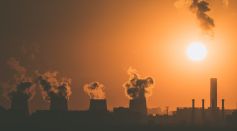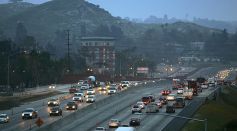Tags: Climate change

Long-Term Air Pollution Exposure Effects on Physical Health Identified, Is It Really Risky?
Marine Biologists Develop Heat-Resistant Coral to Save Great Barrier Reef
Climate Change Threatens Yellowstone National Park, Less Snow and Warmer Days Expected
Marine Ecosystems: Life After Mass Extinctions, May Take 4 Million Years to Recover, New Study Reveals
NASA Says Earth Is Absorbing "Unprecedented" Amount of Heat, Solar Cycles Not an Issue

"Hummingbird Whisperer" Feeds Over 200 Birds with Specialized Nectar Mix As They Buzz Outside Her Office

Ozone Pollution Decline Observed During Pandemic Lockdown as Global Emissions Dropped by 15%
Is It Possible to Change Earth's and Moon's Orbit to Fight Climate Change?

Atmospheric Carbon Dioxide Now Reaches 50% Higher Than the Start of Industrial Revolution
Megaconstellation Satellites Reentering Puts a Hole in Ozone Layer, Increases Atmosphere Pollution, and Uncontrolled Geoengineering
'Sea Snot' in Turkey Killing Marmara Sea: How It Endangers Both Humans, Marine Ecosystem
Dead Zones Recurrently Forming in North Pacific During Warm Climates, Abrupt Episodes Happen Over the Last 1.2 Million Years

Global Warming Leads to "Watershed" 1.5°C Increase, UN Weather Arm Warns
How International Space Station Helps Experts Study Climate Change on Earth
Thick Sea Snot Covers the Sea of Marmara in Turkey, Could It Be Due to Climate Change?
NASA's Earth System Observatory to Study How Climate Change Fuels Natural Disasters

Climate Change May Have Caused Major Population Collapse of Amazon Indigenous People 400 Years Before European Arrival
Hottest Spot on Earth: Iran's Lut Desert Beats Death Valley With Temperature Reaching 80°C
Climate Change Linked to Intensity Hurricane Sandy Boosting Damages by at Least $8 Billion

Human Survival Under Threat as More Than 37,400 Animals Species and Microorganisms at Risk of Extinction
Most Popular

Microplastics Are Everywhere — How Plastic Pollution Threatens Wildlife, Soil, and Water

Brain Health Aging Guide: Effective Strategies for Cognitive Decline Prevention and Lower Dementia Risk

Mitochondrial Health and Aging: How Cell Energy Drives Modern Anti-Aging Science

How Scientists Use Radio Telescopes to Search for Alien Signals Across the Universe





